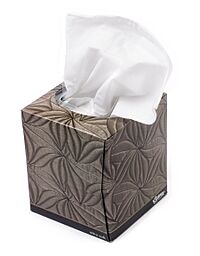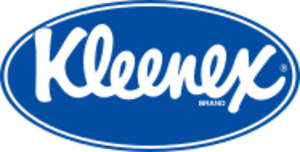Kleenex facts for kids

Logo used since 2024 with an updated color based on the 2020 logo
|
|

A box of Kleenex facial tissues
|
|
| Type | Facial Tissue |
|---|---|
| Owner | Kimberly-Clark |
| Country | United States |
| Introduced | June 12, 1924 |
| Markets | Worldwide except Canada |
| Previous owners | International Cellucotton Products Company |
| Registered as a trademark in | USA |
| Website | https://www.kleenex.com/en-us/ |
Kleenex is a famous brand name for facial tissues. The name is so popular that many people say "Kleenex" when they mean any kind of tissue, even if it's made by a different company.
When a brand name becomes the common name for a product, it's called a genericized trademark. Kleenex is a registered trademark owned by the company Kimberly-Clark. Besides tissues, the brand has also been used for other paper products like napkins.
Contents
The Story of Kleenex
The idea for Kleenex tissues came from a surprising place and has an interesting history.
From War Filters to Face Wipes
The story of Kleenex starts during World War I. A company created a special paper material called Cellucotton. It was used as a filter in soldiers' gas masks. After the war, the company looked for new, peaceful ways to use this material.
First, they changed it to create another type of personal care product. Then, they made the paper even thinner and softer. In 1924, this new product was named "Kleenex." It was first sold as a gentle way to remove makeup and cold cream.
The name "Kleenex" was chosen because it was short and easy to remember. The "Kleen" part sounds like the word "clean," showing what the product was for.
A Handy Helper for Colds
In 1925, magazine ads for Kleenex featured movie stars who used the tissues for their skin. But soon, the company discovered a new use for them. A researcher suggested that the tissues would be great for people with a common cold or hay fever.
At first, the company wasn't sure, but they decided to try it. They started advertising Kleenex as a disposable handkerchief. By the 1930s, this idea became very popular. Their slogan was "Don't Carry a Cold in Your Pocket," which encouraged people to use a fresh tissue instead of a cloth handkerchief.
To make the brand even more popular, Kleenex started using the cartoon character Little Lulu in its ads in 1943.
Kleenex Becomes a Famous Name
The brand name "Kleenex" is legally protected, but it has also become a common word in everyday language.
What is a Trademark?
The name "Kleenex" is a trademark. A trademark is a special name or symbol that a company legally owns to identify its products. The company first registered the Kleenex trademark on November 25, 1924. This means no other company can sell facial tissues using the same name.
Today, the Kleenex trademark is owned by the Kimberly-Clark company.
So Popular, It Became a Nickname
Kleenex tissues became so popular in the United States that many people started calling any brand of facial tissue a "Kleenex."
Even though it's not legally correct, the name is now so common that some dictionaries, like Merriam-Webster and Oxford, list "Kleenex" as another word for a facial tissue.
In 2023, Kimberly-Clark announced it would stop selling Kleenex in Canada. The company said it was too expensive to ship the products there.
Other Kleenex Products
While Kleenex is best known for tissues, the brand name has been used for other things too. For a short time in the 1970s, Kimberly-Clark sold disposable diapers called "Kleenex Super Dry Diapers."
These diapers had a fun feature: a design on the outside that would fade as the diaper got wet. Today, Kimberly-Clark sells its diapers under the famous Huggies brand name.



